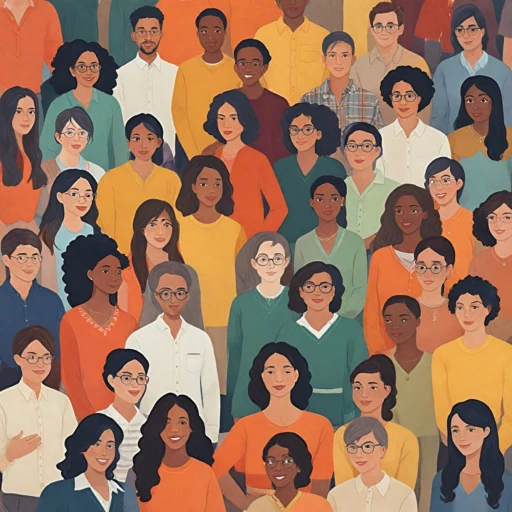Understanding the Need for Continuous Employee Development
The Imperative of Employee Development in Today's Dynamic Business Environment
Gone are the days when a job for life was the norm and career progression followed a set path. Organizations that thrive in the modern business arena acknowledge the significance of fostering ongoing professional growth. The landscape of employee expectations has shifted, with a Gallup poll revealing that 87% of millennials consider development opportunities as critical in a job. Moreover, an organization's commitment to developing employees stands as a beacon of its commitment to their success.
Organizations are recognizing that to remain competitive, they must continuously invest in their most precious asset—people. It's more than a nice-to-have; it's a strategic imperative. Recognizing this, cultivating a culturally attuned and skilled workforce is taking center stage in company strategies. In fact, the Society for Human Resource Management (SHRM) underscores the value by highlighting the critical role employee development plays in retaining talent and driving business outcomes.
Key Strategies to Foster Employee Empowerment
Proactive organizations implement a variety of tactics to support professional betterment. Encouraging individuals to chart their own career paths, providing access to learning platforms, and embedding mentorship are just some of the strategies used to spur advancement.
Through personalized development plans, employees receive a roadmap tailored to their ambitions and the needs of the business. These plans often encompass a plethora of discourses—from deepening technical competencies to honing leadership savvy. This personalized approach not only aligns with the individual's career ambitions but also with company objectives, translating into a win-win scenario for both the employee and business longevity.
The Role of Employers in Shaping Career Journeys
An effective development strategy requires more than just offering opportunities; it demands active employer participation in shaping their employees' career journeys. Marsh McLennan's annual report suggests that companies which invest in comprehensive training and development programs are likely to witness a substantial increase in employee engagement and productivity.
By creating a culture that not only supports but also celebrates growth, businesses can ensure that their employees feel valued and invested in the success of the organization. This not only bolsters employee morale but also enhances the overall talent pool within the company, preparing the workforce to meet future challenges head-on.
The Power of Personalized Development Plans
Customizing Growth: The Power of Personalized Development Plans
Every individual within a company brings unique strengths, aspirations, and career trajectories to the table. Recognizing this diversity, progressive companies are now tailoring personalized development plans to foster professional growth and unlock the full potential of their employees. This strategic move not only bolsters employee engagement but also contributes to shaping a workforce that is resilient, adaptable, and realistically aligned with the company’s long-term vision.
Several studies underscore the benefits of this approach. For instance, Gallup research indicates that employees who feel their strengths are being used every day are 8 times more likely to be engaged in their jobs. Personalized development plans take this insight further by aligning individual employee goals with organizational objectives, ensuring a harmonious pursuit of success.
Mapping Ambitions: Employee Aspiration Meets Business Objectives
At its core, an employee development plan is a collaborative roadmap created by the individual employee and their manager. It plots a course that includes not just career paths but also opportunities for learning development and acquiring new skills. For example, an employee with a knack for interpersonal relations might have goals that lean toward leadership roles. The development plan could include steps such as targeted training development programs, mentorship sessions, and a timeline for progression.
In the process, companies are shifting away from the traditional career ladder—a once-size-fits-all approach—to a more nuanced career lattice. This system allows for lateral moves, job rotation, and a variety of development opportunities to help individuals grow within the company without necessarily moving up a static hierarchy.
Tailoring Learning to Fit the Individual
It’s not just about having a plan; it’s also about ensuring it’s actionable and relevant. Organizations are leveraging tools like skills gap analysis and performance metrics to create a framework that is as dynamic as the people it’s designed to help. Training and professional development opportunities are becoming more customizable. Packages range from in-house workshops to online courses that cater to different learning styles and schedules, thereby enhancing the availability and accessibility of resources for employee development.
Social learning and collaboration platforms allow employees to learn from peers and experts within their field, thereby cementing a culture of continuous growth. For workers on the go, microlearning modules enable a snackable, yet highly effective method of gaining new knowledge, fitting neatly into the rhythm of day-to-day responsibilities.
The Seamless Integration with Company Culture
An established culture of learning and growth is vital to the successful implementation of personalized development plans. Leading companies don’t just offer development programs; they weave them into the fabric of their daily operations, thereby reinforcing the importance of ongoing development. This helps in creating a supportive environment where seeking out development is the norm, and where growth is both expected and celebrated.
To solidify this, organizations integrate recognition programs that celebrate educational milestones and the application of new skills to the job. When employee training development becomes a cornerstone of company culture, it encourages workers to take ownership of their growth, generating a proactive attitude that’s a win-win for both the individual and the business.
At the heart of cultivating a great place to work is the understanding that when employees see real value in the development opportunities presented, their connection to the company deepens, paving the way for greater innovation and collaboration.
Employees are looking for more than just a place to work; they’re seeking a path to fulfillment and success. Personalized development plans are a clear indicator that an organization is willing to invest in its people, not just as workers, but as professionals aspiring to achieve their greatest potential.
Innovative Learning Platforms and Their Role in Professional Growth
Embracing Modern Tech for Enhanced Learning
Stepping into the modern era where technology reigns supreme, companies are swiftly adopting innovative learning platforms as a cornerstone for professional advancement. The digital age has given birth to a variety of learning management systems (LMS), each boasting features that drive employee engagement and foster a seamless learning development journey. Notably, a study by Gallup indicated that amongst U.S. workers, those who feel they have opportunities to learn and grow are 59% more likely to report feeling engaged in their job.
Revolutionizing Training with Adaptive Learning
Adaptive learning technology represents a monumental shift in crafting personalized development opportunities. Tailored to assess an individual's skill level and learning pace, these platforms adapt in real-time, offering a unique pathway suited to each learner's progress. They're superb tools for corporations dedicated to nurturing their talent and bridging skills gaps. Employers who have implemented adaptive learning platforms report seeing measurable improvements in productivity and professional competency. The Corporate Executive Board (CEB) now Gartner, identifies personalized learning paths can improve employee performance by as much as 12%.
Interactive Learning: A Touchstone for Engagement
Interactive platforms go beyond the passive consumption of information. They encourage active participation, bolster employee experience, and enhance retention rates through simulations, gamified elements, and real-time feedback. Delving into Deloitte's Human Capital Trends, organizations investing in these interactive methods see a substantial increase in employee satisfaction. Employees are not just learning; they're engaging with content that resonates, solidifying both their knowledge and affiliation with the company's long-term goals.
For concrete examples, one may look no further than cross-functional management, which utilizes platform-based learning to catalyze cross-departmental understanding and collaboration, dramatically enhancing organizational employee development.
Democratizing Access to Knowledge
The beauty of digital platforms lies in their ability to democratize learning – making professional development opportunities accessible to a broader spectrum of the workforce. Employees at all levels are given the keys to a repository of knowledge and training resources, ensuring that no matter where they stand on the career ladder, growth and advancement remain within their grasp. The Society for Human Resource Management (SHRM) posits that this kind of accessibility has a positive correlation with employee retention and engagement.
Seamless Integration with Career Development Plans
When learning platforms are integrated with well-thought-out development plans, they become a powerful engine driving the company's long-term success. Each employee's journey on the platform can be aligned with their career development plan, allowing for a harmonious synergy between personal goals and organizational objectives. According to CSO Insights, companies that have a dynamic approach to aligning individual learning paths with business needs are 32% more likely to be sales performance leaders.
Analytics-Driven Insights for Targeted Enhancement
The troves of data generated by learning platforms grant HR and L&D professionals unprecedented insights into the development needs of their workforce. Through analytics, businesses can fine-tune training programs, provide real-time coaching, and forecast future learning needs, paving the way for a more robust employee development ecosystem. Strategies such as job rotation programs are also enhanced when underpinned by data, matching employees with experiences that best serve both their career trajectory and the firm's strategic positioning.
Forging Ahead in Professional Growth
Embracing innovative learning platforms ushers in a new chapter where professional growth is not just encouraged but ingrained in the fabric of a company's ethos. As Marsh McLennan's Insights closing remark, firms that stay ahead of the curve in adopting next-gen learning solutions will groom a workforce that's not only more skilled but deeply invested in the journey towards excellence.
Mentorship and Coaching as Pillars of Employee Advancement
Mentorship: A Personal Touch in Professional Development
In an era where professional development is paramount, mentorship has stepped up as a key player in the game of career advancement. Organizations are realizing that beyond traditional training, human touchpoints such as mentorship and coaching are invaluable. Taking a leaf from the insights provided by SHRM, a staggering 71% of Fortune 500 companies offer mentorship programs, underlining their commitment to developing employees.
Coaching: Amplifying Potential Through Guidance
Coaching, on the other hand, has shown to be a potent tool for employee development. According to a survey by the International Coaching Federation, companies that implemented coaching saw an average return on investment of 700%. This deep dive into individual potential ensures that employee training development aligns with the company’s strategic vision, fostering not only career growth but also organizational synergy. Experts like John Maxwell, author of 'Developing the Leader Within You', have long championed the cause of transformative coaching in nurturing leadership skills among professionals.
Integrating Mentorship and Coaching into the Development Fabric
The integration of mentorship and coaching into employee development plans offers a dual approach towards career progression. Mentorship programs, often highlighted in reports by C-suite advisors like Marsh McLennan, suggest that mentor-mentee relationships contribute to a fulfilling employee experience and boost employee engagement. By sharing their journeys, mentors help employees navigate their own career paths, acting as compasses towards each individual’s North Star.
Cultivating Growth with Cross-Pollination
Cross-pollination of knowledge and experience is another aspect of mentorship that adds a layer of richness to the development fabric. This approach aligns with research indicating that employees who engage in diverse work experiences, as suggested in L&D reports, are better equipped to take on leadership roles. Case studies demonstrate that mentorship can serve as an effective bridge, connecting individuals with seasoned professionals who offer insights beyond the traditional career ladder, and instead focus on comprehensive people development.
Retention and Engagement: The Hidden Benefits of Coaching and Mentorship
One cannot overlook the retention factor when discussing mentorship and coaching. Gallup studies have shown that diligent mentorship and coaching lead to higher employee retention rates. When employees feel valued through personalized attention and professional development opportunities, their loyalty to the company strengthens. Additionally, organizations that excel at employee development are often recognized as great places to work, which boosts their attractiveness in the competitive job market.
Conclusion
In summary, organizations keen on developing employees must tap into the power of mentorship and coaching. By nurturing these channels, businesses can not only enhance individual career trajectories but also cement a robust foundation for their long-term success. With expert guidance, personalized development, and genuine interest in employee growth, companies can build a workforce that is not only proficient but also deeply engaged and committed to the corporate vision.
Exploring the Potential of Job Rotation and Cross-Training
Harnessing Job Rotation to Spark Dynamic Growth
These days, businesses recognize that an adaptable workforce is key to staying competitive. Job rotation and cross-training stand out as savvy strategies to spice up the career paths within a company. These methodologies offer employees fresh perspectives and diverse experience, leading to a more satisfied and versatile team. Let's swing into how these practical tools can revamp employee development.
Unlocking New Skills and Perspectives
Job rotation programs are the golden ticket for employees eager to escape the humdrum of daily routines. By shifting roles within the organization, individuals can uncover hidden talents, tackle invigorating challenges, and broaden their understanding of the business. It's not just the employees; companies reap the benefits too. Recent stats from the Society for Human Resource Management (SHRM) highlight that job rotation can bolster employee engagement by showing an investment in their growth.
Paving Career Pathways with Cross-Training
In the quest for undergoing professional metamorphosis, cross-training emerges as a top-notch tactic. Employees amplify their skillset by learning parallel job functions, which can be a lifeline during peak business cycles or when filling in for absent colleagues. More so, a Gallup study showcases how such developmental opportunities engrain a sense of purpose among employees, as they perceive their growth aligned with the company's success.
Strategic Implementation for Long-term Success
Embarking on the journey of job rotation and cross-training calls for meticulous planning. Crafting a robust employee development plan involves aligning individual ambitions with organizational needs. It's similar to piecing together a jigsaw puzzle where every bit contributes to the larger picture of company longevity.
Tools such as skills gap analysis equip managers to tailor these programs effectively. A case study from Marsh McLennan illustrates how a structured approach to job rotation can foster innovation and break down silos within a global enterprise. Distinct from traditional career ladders, it unleashes a workforce that is resilient and prepared for future business shifts.
Case Studies: Stellar Examples of Sweeping Success
Take a peek at companies that are already champions of employee development via job rotation. For instance, a noteworthy example is a multinational tech company that implemented a rotational program resulting in a dramatic uptick in cross-functional collaboration and a substantial decrease in employee turnover.
Another success story is drawn from a consumer goods corporation that found cross-training to be the linchpin in keeping their operations agile against the backdrop of fluctuating market demands.
Conclusion: A Blend of Strategy and Flexibility
Job rotation and cross-training aren’t simple one-off activities; they require a continuous commitment and an openness to change. For employees, it's the runway to sashay through various job roles, enriching their career and personal development. For organizations, it's an investment that translates into a workforce that's not only skilled but also inspired to drive business forward. The outcome? A vivacious workplace brimming with folks ready to contribute in multifaceted ways, armed with an array of experiences they can draw upon to help the organization soar.
Maximizing Opportunities Through Continuous Skills Gap Analysis
The Role of Skills Gap Analysis in Employee Development
In an era where change is the only constant, maximizing opportunities for developing employees means understanding what's missing. That's where the meticulous process of skills gap analysis comes into play. It's like giving your organization a health check-up; you identify the critical skills your workforce lacks and then create a roadmap for filling those gaps. Progressive companies understand that to remain competitive, they need to be proactive in identifying and bridging these gaps.
How to Conduct an Effective Skills Gap Analysis
Conducting a comprehensive skills analysis begins with delineating current job roles and the competencies they require. Next, we assess the existing skills of our employees, which often reveals a chasm between the current state and the ideal proficiency level. It’s crucial to include both hard and soft skills in this analysis. One study by Gallup indicates that when it comes to thriving workplaces, emotional intelligence is just as significant as technical acumen.
Employee involvement in identifying development needs not only amplifies engagement but also ensures the accuracy of the findings. Therefore, this isn’t just HR’s or management's responsibility – it's a collaborative effort. After all, who better understands the intricacies of their daily tasks than the employees themselves?
Linking Skills Analysis to Training Development
Once the gaps are clear, the next step is harmonizing them with targeted training development programs. Customized training solutions breathe life into your analysis outcomes by directly addressing the gaps. For instance, if the analysis indicates a widespread need for improved data analysis skills, the company might invest in a series of workshops tailored specifically to current business needs.
Bespoke training initiatives, such as offering courses on emerging technologies or leadership workshops for high-potential employees, can be particularly impactful. According to the Society for Human Resource Management (SHRM), businesses are amplifying their efforts in tailored employee development to foster a workforce that can adeptly handle future challenges.
Synchronizing Career Development and Business Goals
Skills gap analysis isn't just about the now – it's a strategic move for the future. It's about aligning individual career paths with the evolution of the company. Employees aspiring to climb the traditional career ladder might find themselves equipped with a personalized career development plan that echoes the company's long-term vision.
An insightful report by Marsh McLennan highlights how aligning employee's career developments with business strategy leads to mutual growth. Employees see a clear trajectory for advancement, and companies cultivate a workforce that's prepared for tomorrow's business landscape.
Real-World Examples Showcase the Power of Development
Take the tech giant Google for instance, which employs ongoing skills gap analyses to inform its renowned employee development programs. Not only does this ensure that their teams maintain industry-leading expertise, but it also plays a crucial part in sustaining their status as a great place to work.
Similarly, Deloitte uses skills gap assessments to identify and deliver potent professional development opportunities, thereby maintaining its edge as a leader in professional services. These examples prove that robust employee development initiatives powered by detailed gap analyses are not corporate luxuries but business necessities.
Continuous Improvement Drives Long-Term Success
Prioritizing continuous improvement through skills gap analysis isn't just about staying competitive. It's about showing employees that the organization invests in their growth and development. This interest in their professional future can result in higher levels of employee engagement and employee experience, key factors that drive corporate success according to leading organizational consultants like CSO.
Implementing what we discover from our skills assessments can transform our approach to development, creating dynamic career paths and learning opportunities that support not only the individual's goals but also the broader objectives of the company.
Measuring the Impact of Employee Development Initiatives
Gauging Development Strategies Against Business Outcomes
It's not just about launching training programs and hoping for the best. In today’s competitive landscape, it's downright essential for companies to track the success of their employee development strategies. This means transcending traditional employee satisfaction surveys and looking into how development initiatives align with and impact business outcomes. According to a Gallup report, businesses with a strong learning culture enjoy employee engagement and retention rates around 30-50% higher than those that don't.
Applying Analytical Rigor to Employee Advancements
Evidence-based approaches are proving invaluable in discerning the effectiveness of employee development. Ministries of data are being established within forward-thinking organizations to collate and analyze training outcomes alongside performance metrics. From a recent SHRM study, companies that applied analytics to their training development programs saw a marked improvement in employee performance by up to 25%.
Remember, we’re not just talking about number-crunching. It's about revealing stories behind data that inform strategic decisions and foster employee career growth. Savvy organizations are those that recognize the significance of quantifiable metrics in shaping robust employee development methods, leading to a thriving workplace that retains its talent.
Linking Learning to Performance Metrics
Let’s be real here, data is great but what does it mean for Joe or Jane in accounting? By linking learning directly to performance metrics, organizations illuminate the pathway from development to payoff. This is about creating transparency and understanding how directly improving skills impacts business metrics. Are customer satisfaction scores on the rise because of that recent communication training? Companies understanding this connection can better plan their long-term strategies for people development.
For instance, development opportunities tied to key performance indicators (KPIs) have become a significant trend. Companies are now integrating their learning development strategies with real-time feedback loops to adjust and align with the desired goals. A CSO Insights study pegged companies with dynamic coaching programs as having 91% higher year-over-year increase in sales than those without.
Case Studies in Employee Development
Take Marsh & McLennan, a global professional services firm, whose employee development programs are linked with its strategic goals. Their career development pathways are not about checking off skills on a list, but about enriching the employee experience to boost innovation and service excellence. Organizations like Marsh & McLennan are setting the pace for how employee skill growth leads to tangible business benefits.
Connecting Development to Retention and Engagement
Finally, let's talk retention and engagement – two critical areas often left out of the success equation. An effective employee development program isn't just a perk; it's a magnet for keeping talent. Surveys by entities like L&D report that companies investing in employee development reduce turnover by as much as 34%. It's no rocket science – employees feel valued when businesses invest in their career paths, and they usually pay it forward in dedication and growth-committed work.
To round it all off, developing employees is more than just a feel-good factor. It's a strategic business initiative with quantifiable impacts on the overall success and longevity of a company. When employee development is done right, everyone stands to win – from the ground up. People grow, opportunities bloom, and the company reaps the rewards of a cultivated, inspired workforce poised for the challenges ahead.
Creating a Culture that Celebrates and Encourages Growth
Embedding a Growth Mindset within the Organization
At the heart of fostering a workplace environment that not only acknowledges but indeed celebrates development lies the concept of a growth mindset. This philosophy espouses that abilities can be developed through dedication and hard work. Companies that imbue this mindset into their culture are better placed to motivate and retain their workforce. Studies suggest that an organizational culture deeply rooted in continuous learning and adaptability is more likely to innovate and stay ahead in competitive markets.
Catalysts for Employee Driven Development
Employees who feel their personal growth is valued often show increased engagement. Organizations like Gallup have discovered a correlation between employee engagement and performance. To this end, providing clear pathways for career advancement and ensuring that employees are aware of these channels is paramount. This not only enriches the employee experience but also equips the company with a more skilled and agile workforce.
Leveraging Leadership to Model Development
Leaders who actively participate in and advocate for their own development serve as powerful examples. Their actions communicate that learning and progression are integral to the company’s values. When leaders share their learning journeys, including challenges and successes, it contributes to a transparent and supportive culture that prioritizes development.
Recognizing and Rewarding Growth to Inspire Further Advancement
Recognition is a potent tool in motivating employees to engage in their growth actively. By celebrating milestones and accomplishments in professional development, a company sends a clear message about its commitment to its workforce. Tactics such as acknowledging progress during meetings or providing opportunities for employees to showcase their newly acquired skills can have substantial positive impacts.
Integrating Development into the Fabric of Daily Work
The longevity of any employee development initiative hinges on its integration into daily tasks and responsibilities. Development should not be seen as an activity separate from work but as a part of it. Organizations that successfully blend learning with work opportunities help employees apply new skills in real-time, allowing for immediate reinforcement and integration.
Concluding Thoughts
Building a culture that advocates growth and advancement is not an overnight transformation. It involves strategic planning and a consistent commitment from the top down. With the proper attention to nurturing a learning ecosystem, businesses can become havens for professionals keen on developing their careers hand-in-hand with the company’s trajectory. Ultimately, this cultural shift is about creating an environment where every person is encouraged to expand their horizons, adding richness and depth to both their professional lives and the organization at large.














